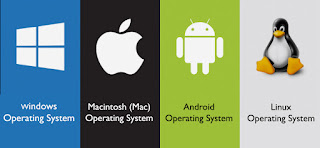Operating System
Definition
An Operating System is a system software that acts as an interface between computer hardware and the user and controls the overall execution of a computer system. Some examples are, DOS, Windows, Linux, etc.
 |
| Some popular Operating System |
Functions of an Operating System
Following are some important functions of an Operating System
Memory Management: Memory management means the management of Primary or Main memory. Main memory is a large area of collections of characters or byte where each character or byte has its own address. An Operating System does the following activities for memory management -
- Keeps tracks of primary memory.
- In multi programming, the OS decides which process will get memory when and how much.
- Allocates the memory when a process requests it to do so.
- De-allocates the memory when a process no logger needs it or has been terminated.
Processor Management: In multi programming environment, the OS decides which process gets the processor when and for how much time. This function is called process scheduling. An OS does the following activities for processor management -
- Keeps tracks of processor and status of process.
- Allocates the processor (CPU) to a process.
- De-allocates processor when a process is no longer required.
I/O Management: One of the important functions of an Operating System is to manage and control the various types of Input and Output devices like, mouse, keyboard, monitor, printer, touch pad, etc.
 |
| Role of an Operating System |
File Management: Basically, we organize files into some directories for easy navigation and usage. These directories are contain different files and many other directories. An OS does the following activities for as file management -
- Keeps track of information, location, uses, status, etc.
- Decides who gets the resources.
- Allocates and De-allocates the resources.
Security: Operating System (OS) prevents unauthorized access to program and data by providing password facility. It protects our system from hacking.
- Operating System provides a platform, on top of which, other application programs can run.
- Operating System allows the computer to manage its own resources such as memory, monitor, keyboard, etc.
- Operating System provides the user an easy-to-work UI (User Interface), so the user doesn't have to learn a different UI every time and can focus on the content.
- Operating System allows multiple programs to run in their own space can communicate each other through shared memory.
- Operating System also provides high security to our computer system.
Booting
After switch on the machine, the Disk Operating System (DOS) is loaded in main memory which involves three essential files viz., IO.SYS, MSDOS.SYS, COMMAND.COM. The process of loading these files into the main memory is called booting.
There are two types of booting and they are:
Cold Booting: When the computer is switched on, it starts from what is called cold state. The booting at this state is termed as cold booting. In cold booting RAM test takes place.
Warm Booting: When the computer hangs or it is not responding to any job at the item of working, then the computer should be started from the beginning. To start from the beginning, we press the ALT, CTRL and DEL key simultaneously. After pressing these keys simultaneously the computer starts from the beginning i.e., it restarts again. This process is called warm booting, RAM does not take place in warm booting.
Virtual Memory
Virtual memory is a temporary memory space allocated in the computer's disk storage space for performing an operation and disposing it once the process is completed. The most important part of virtual memory occurs when programs try to use more virtual memory than there is real memory . In this process the overlays are transferred to primary memory from the secondary memory when they are needed.
Spooling
When more than one programs are wanting to use the same device then they are standing in a queue waiting for that device (say printer). To increase the utilization of dedicated devices or to speed up I/O operation, a technique called SPOOLing (Simultaneous Peripheral Operations On-Line) has been introduced. A disk file, which is automatically associated with the program, acts as a virtual printer.


0 Comments:
Post a Comment